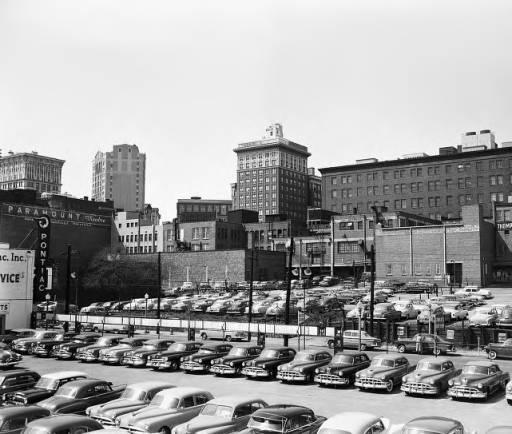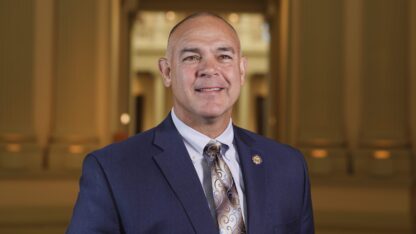Tim Keane is no fan of free parking.
“That has been proven time and again, in every single city in the world that the more parking you provide, the more people drive,” said Keane, who became Atlanta’s planning commissioner last summer. “I mean, we live in Atlanta. This is a city that is a great example of: If you design for everyone to drive, then what will you get? Congestion.”
Transportation alternative advocates have been saying this for a long time, and late last year, researchers at the University of Wisconsin and the University of Connecticut agreed.
But what does this mean for Atlanta, a city trying to combat its reputation as a car town?
Parking Or Density?
Since becoming Atlanta’s planning commissioner, Keane has made it clear: He wants to reduce off-street parking. It’s part of his goal to cut traffic while making Atlanta friendlier to cyclists and pedestrians.
But it’s not a simple prospect.
One example is located in front of Inman Quarter, a newish apartment complex at the once-quiet intersection of North Highland Avenue and Elizabeth Street.
Keane is a big fan of the urban infill this development represents — filling in land with dense development. But he doesn’t like the 570-space public parking deck that came with it.
“We really need to shift now, from a situation like this, where you have a heavy parking load associated with an apartment building in a very urban setting, to way less parking,” he said.
For dense neighborhoods that are close to transit, Keane favors strictly limiting the number of off-street parking spots that come with new developments.
As far as the “chicken or egg” question of whether transit should come first, or density and limited parking, to Keane, the answer is clear:
“I hear this all the time. ‘Well, we don’t want the density unless we get the transit.’ Well, I’ve got news for you. You really have to start with the density and less parking. If you don’t, then you’ve lost your opportunity, because once you’ve built that infrastructure, it’s so difficult to undo that.”
In other words, once people have parking, they don’t like for it to be taken away. And parking infrastructure … it has a way of becoming entrenched.
Atlanta’s Parking Lot Desert
Case in point: downtown Atlanta.
It’s a neighborhood covered in parking infrastructure, with lots and decks totaling some 93,000 parking spaces, many of which sit unoccupied most of the time.
Georgia State University librarian Joseph Hurley stood on the roof of a nine-story parking deck at the corner of Peachtree Center Avenue and Ellis Street. The view from here was dramatic — or maybe just dramatically dull — decks and lots spanning for blocks.
Hurley put together an archive of city planning documents that tell the story, among other things, of why downtown looks like this.
“When people think of Atlanta as a car-centric area, it wasn’t always that way,” he said. “It was through policy decisions that Atlanta became that way.”
Through much of the 20th century, those policy decisions made one recommendation again and again, decade after decade: Build more parking lots.
“When a lot of these parking garages and surface-level parking lots were built in the 1950s and 1960s, a large part of the American population really believed that driving your car was a signifier of a modern lifestyle,” Hurley said.
It was the age of white flight and the rise of the suburbs. City leaders in Atlanta — and everywhere else — feared this “decentralization.”
“And they really thought it was because downtown did not have sufficient parking for the automobile,” said Hurley, “whereas today, many people have a complete opposite idea, and they want to live in areas where you can walk to the places that you need to go.”
City planners and downtown boosters are onboard with transforming downtown’s desert of lots and decks into new uses.
But getting rid of lots that go largely unused is easier said than done.
What To Do With An Old Parking Lot?
Jennifer Ball laughed a bit wryly at the turnaround: People now want density, when urban planners spent decades eradicating it in spaces like downtown, by bulldozing many of the old buildings that once stood here.
She’s vice president of planning and economic development for Central Atlanta Progress, a nonprofit that wants to transform downtown into a truly dense, walkable community — the kind that news stories always say millennials want to live in.
And now, she said, we’ve hit a threshold:
“In downtown’s case, we are in a point in our redevelopment and revitalization where some of the parking lot land is now more valuable to be buildings than it is to continue to be held just for parking.”
Still, Ball ticked off a laundry list of challenges to finding new uses for those lots.
First off, the people who built lots and decks that have sat here for decades? They usually weren’t developers. They were the owners of buildings in a post-war downtown that was emptying out.
“The city was growing and sprawling,” said Ball, “and we wanted to accommodate these new cars that everyone was buying, and so it was the wave of the future for everyone to drive to work and have a great place to park their car.”
So, people tore down their downtown buildings — sometimes, their houses — and built parking lots to earn some money.
Some of these lots and decks have been owned by the same family for generations, Ball said, “And then the properties are put into a trust for their heirs, and that gets handed down … and so, you’re trying to convince 16 or 18 different heirs that they should sell!”
“So, it gets complicated,” she added, laughing.
It doesn’t get much simpler once developers have tracked down those owners and it comes time to agree on a price.
Because while the lots may not get much business, the income they do earn is guaranteed, year after year. Those lots may also house billboards — generating even more revenue for the owners.
The result is predictable. Ball says that what “a developer wants to spend in order to redevelop it doesn’t always align with what the owner thinks their property is worth.”
There are grants to help developers offer higher payouts, and academics have floated solutions like raising property taxes for underdeveloped land. But that move would require a change to Georgia’s Constitution.
Meanwhile, Ball said some owners may be waiting for a really big break, such as the next Bank of America Tower … not a six-story apartment building, like the one going up across the street from a construction site that will house the future Post Centennial Park.
With more than 400 units, the apartment complex, which broke ground in February, will span two blocks — blocks that, like many in this neighborhood, housed parking lots for years.
Ball said it took years to convince the multiple owners of those lots to sell.
But there will be parking at Post Centennial Park. The parking garage will offer one space per bedroom, which Ball said is pretty standard for downtown.
On whether building such a garage in a dense, transit-adjacent place like this is only encouraging more people to drive in the long run, as Tim Keane suggests, Ball called that a “tricky wicket.”
“Because we certainly want to encourage more housing in downtown,” she said, “and if in 2016 that means that we need to provide a parking space for those apartments, then we certainly understand that.”
She said it’s a balancing act — one that may include plans to tear down garages like these in a future with better transit and infrastructure for pedestrians and cyclists.
As downtown tries to strike that balance, the rest of the city will be surely watching.










